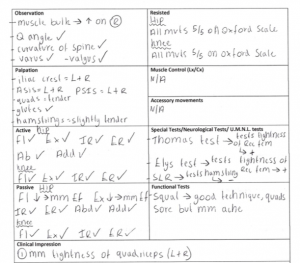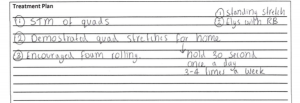In this hour, I massaged a client who had tight quadriceps from a hockey match a few days ago.
Reflective Summary
During the session I used massage where the effects can be both physiological and psychological (Findlay, 2018). I used a variety of established massage techniques including effleurage, petrissage and tapotement (Ogai, Yamane, Matsumoto, & Kosaka, 2008). I started with effleurage as it stimulates the flow of lymph fluid that leads to increased drainage of waste products, as well as inducing relaxation and reducing abnormal muscle contraction (Keperawatan, Petpichetchian, & Chongchareon, 2013). Petrissage was used to increase blood flow therefore transporting more oxygen and nutrients to the tissues and removing waste products, promoting an efficient system (Findlay, 2018). Tapotement can also be used to induce muscle relaxation by releasing soft tissue tension, initiates digestive movement through peristalsis, by stimulating the parasympathetic nervous system and again increases lymphatic return thus assisting with the elimination of toxins (Findlay, 2018). A study verified that massage therapy can alleviate subjective symptoms of state anxiety and lower salivary cortisol as an index of psychological stress (Donoyama & Shibasaki, 2010).
Areas for further improvement
My first area for improvement would be to always use objective measures, even if the client has requested a massage. This is because it is important to understand if the treatment provided was effective. The usual objective measures include pain and range of movement (ROM). Another thing that I could improve on would be to explain to the client why I have chosen a specific treatment therapy and what it does. This will allow them to be fully engaged in the session and if an exercise prescription is given to them, they are more likely to understand the activities and complete them.
Things to Remember
- Make sure to massage all of the quadricep muscles, only focus on one muscle if there is more tightness
- Ensure the client is lying supine so you can access the whole muscle as the origins are high up on the leg
- Try to avoid using your fingers too much when massaging, you can use your thumbs, knuckles and forearms to achieve the same aims
References
Donoyama, N., & Shibasaki, M. (2010). Differences in practitioners’ proficiency affect the effectiveness of massage therapy on physical and psychological states. Journal of Bodywork and Movement Therapies, 14(3), 239-244.
Findlay, S. (2018). Sports massage. Champaign:Human kinetics
Keperawatan, C., Petpichetchian, W., & Chongchareon, W. (2013). Does Foot Massage Relieve Acute Postoperative Pain? A Literature Review. Nurse Media Journal of Nursing, 3(1), 483-497.
Ogai, R., Yamane, M., Matsumoto, T., & Kosaka, M. (2008). Effects of petrissage massage on fatigue and exercise performance following intensive cycle pedalling. British Journal of Sports Medicine, 42(10), 534-538.
Appendix
Clinical Consultation Form:




